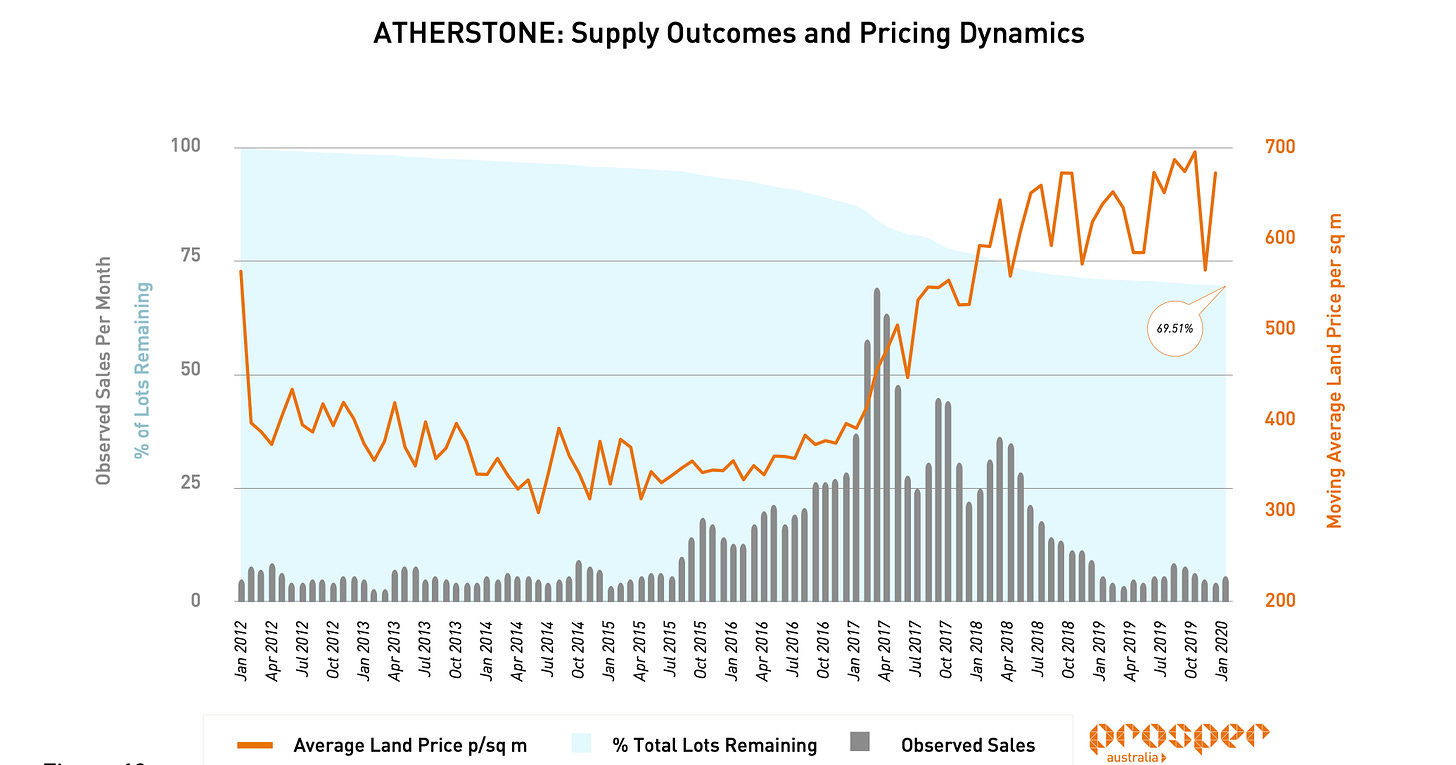Prosper Australia released a report this week entitled Staged Releases:Peering Behind the Land Supply Curtain.
The report is based on an approach I developed in this paper to illustrate the variation in the rate of new housing supply in already approved projects.
The main lesson is that the market has a built-in speed limit on the rate of new housing supply—the absorption rate. I explain the economic logic of the absorption rate in this substack post, and this academic paper. In short, you build faster when demand is growing.
This is precisely what Prosper’s analysis shows.
The chart below shows the development dynamics in one of the case study areas with over 4,000 approved housing lots. The grey bars are the monthly sales (which trigger development in the built-to-order model), and the orange line is the average land price per square metre that month. The blue shading shows the balance of the lots in the project that remain unsold and undeveloped.
Notice the 2016-17 boom in both price and new sales. But in 2018, when price growth slowed, so too did sales, even though the price remained over twice as high as just two years earlier and building more at that time would clearly be profitable, even if it pushed prices down.
The report has attracted plenty of media interest. Property analysts and commentators globally are finally noticing that property owners are the ones who choose how many dwellings to build. The planning system is a secondary concern.
Even Conor Dougherty at the New York Times wrote this week about how “homebuilders across the country are pulling back on development because they can’t sell enough homes”.
This news article about the Staged Releases report got a lot of supportive comments. RMIT’s Emeritus Professor Michael Buxton added his view on how this issue is at the heart of the housing supply debate.
“The government makes available a large amount of land in theory by rezoning and fast-tracking approvals … but the decision is then left to the development company about the rate at which this land supply will be made available. So a lot of them are drip-feeding land out in order to keep land prices high.”
Report author Kark Fitzgerald wrote an opinion piece calling the way new housing supply is released “gold tape”, to distinguish it from the “red tape” and “green tape” that the industry often complains about.
We found that all six developers reduced their sales rate when prices softened. In 2017, as supply had built up to a level that could have pushed prices down, we saw a 48.7 per cent reduction in the rate of sales over the next two years.
That year was to become the most profitable on record for Australian land values, increasing by $683 billion.
Across all developments in our study, the result of supply stalling practices saw an annual price increase of 5.5 per cent above inflation.
Planning departments around the nation have been crucified for decades, but nobody has turned the mirror the other way to see what developers do to preserve their profits. Certainly, planning and infrastructure delivery could be improved, but even if planners turned out approvals overnight, it wouldn’t change the incentive to keep a floor under prices. Forget red or green tape, developers hold supply behind a gold tape: they must ensure there is not enough supply to push prices down.
More interesting is this article, which notes how this control over supply and price would be seen as anti-competitive behaviour in any other industry.
These were my comments that were quoted in the article.
“If the extraordinary markups we see in property, and the understanding the market seems to have about controlling the rate of supply, occurred in any other market it would attract a huge amount of regulatory scrutiny,” he said. “If you saw the markups and the price growth that you see in property, in motor vehicle, in petrol, in fruit and vegetables, in construction materials that would attract regulatory scrutiny, but for some reason it doesn’t in property.”
The funny part is how the very active and vocal developer lobby group, the UDIA, had no comment.
Matthew Kandelaars, chief executive of property industry lobby group the Urban Development Institute of Australia declined to comment on whether there was enough regulation of developers.
I expect that tighter monetary policy will turn demand growth negative, and new housing development will quickly slow, despite prices being the highest in history.
Dr Cameron Murray is co-author of the Book Game of Mates. Subscribe to his written work at Fresheconomicthinking.substack.com.
